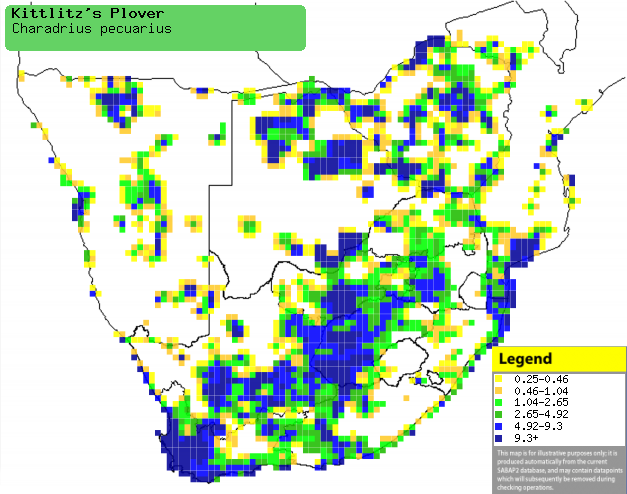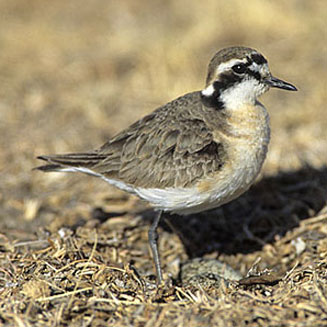|
Charadrius pecuarius
(Kittlitz's plover)
Geelborsstrandkiewiet [Afrikaans]; Herdersplevier [Dutch];
Pluvier pātre [French]; Hirtenregenpfeifer [German]; Borrelho-do-gado
[Portuguese]
Life
> Eukaryotes >
Opisthokonta
> Metazoa (animals) >
Bilateria >
Deuterostomia > Chordata >
Craniata > Vertebrata (vertebrates) > Gnathostomata (jawed
vertebrates) > Teleostomi (teleost fish) > Osteichthyes (bony fish) > Class:
Sarcopterygii (lobe-finned
fish) > Stegocephalia (terrestrial
vertebrates) > Tetrapoda
(four-legged vertebrates) > Reptiliomorpha > Amniota >
Reptilia (reptiles) >
Romeriida > Diapsida > Archosauromorpha > Archosauria >
Dinosauria
(dinosaurs) > Saurischia > Theropoda (bipedal predatory dinosaurs) >
Coelurosauria > Maniraptora > Aves
(birds) >
Order: Charadriiformes > Family: Charadriidae
> Genus: Charadrius
Distribution and habitat
Occurs in Madagascar and sub-Saharan Africa, from Senegal
to Ethiopia south to southern Africa. Within southern Africa it is locally common across much of
the region, largely excluding south-central Botswana and the outer areas of
Namibia, generally preferring open dry mudflats with short grass, usually close
to water. It also occupies estuaries, natural pans, salt-marshes, flood plains
and commercial salt pans, occasionally moving to airfields, golf courses,
overgrazed pastures and ploughed fields.
|
 |
|
Distribution of Kittlitz's plover in southern Africa,
based on statistical smoothing of the records from first SA Bird Atlas
Project (©
Animal Demography unit, University of
Cape Town; smoothing by Birgit Erni and Francesca Little). Colours range
from dark blue (most common) through to yellow (least common).
See here for the latest distribution
from the SABAP2. |
Predators and parasites
A chick was once recorded as prey of a
Blacksmith plover.
Movements and migrations
Mainly nomadic and migratory, moving in
response to rainfall, as for example it travels south-west from
Zimbabwe and northern Botswana to Namibia, southern Botswana and
South Africa, staying from November-July all the while moving
nomadically.
Food
It mainly eats small invertebrates, especially beetles, foraging by day and
night using the typical run-stop-search technique of plover. While foraging it is aggressive towards other Kittlitz's plovers
as well as other species with a similar diet, such as
Common ringed plover and
Curlew sandpiper.
Breeding
- Monogamous, territorial and usually a solitary nester, occasionally
breeding in loose groups.
- The nest is a simple scrape in bare ground, either bare or lined with
pebbles, fragments of vegetation, mud, grass, shell pieces and animal dung.
It is typically placed in coarse sand or dry mud, sometimes raised on a
mound.
 |
|
|
Kittlitz's plover at its nest, Wakkerstroom, South
Africa. [photo
Warwick Tarboton ©] |
|
- Egg-laying season is year-round, peaking from October-January in the
Western Cape, June-November elsewhere in South Africa and from July-October
in Botswana and Zimbabwe.
- It lays 1-3 eggs, which are incubated by both sexes for about 22-28
days, with the female taking the day shift while the male incubates at night.
- The chicks leave the nest within 24 hours of hatching, and are brooded
for about a third of daytime, a practice which ceases once after about six
weeks, although they fledge at about 25-32 days old.
Threats
Not threatened, in fact its range and abundance in southern
Africa have increased due to the construction of artificial water bodies.
References
-
Hockey PAR, Dean WRJ and Ryan PG 2005. Roberts
- Birds of southern Africa, VIIth ed. The Trustees of the John Voelcker
Bird Book Fund, Cape Town.
|
